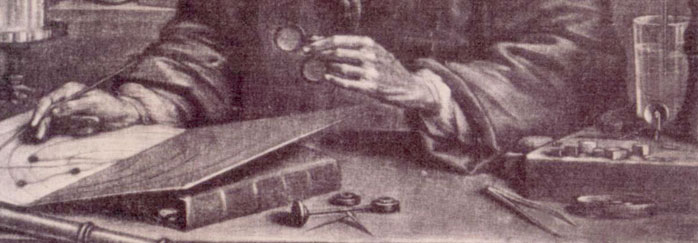Antoni van Leeuwenhoek (1632 - 1723)
 Field(s) of interest: scientific instruments | anatomy | biology
Field(s) of interest: scientific instruments | anatomy | biologyGender: male
Born: Delft, 24-10-1632
Died: Delft, 26-08-1723
Biography:
Leeuwenhoek was originally trained as a cloth merchant and a surveyor. He worked in various positions for the city of Delft: Usher to the Aldermen (1660); Surveyor to the Court of Holland (1669); Chief Warden (1677); Wine Gauger and or Inspector of Weights and Measures (1679). From around 1673 he made microscopes according to the design of Johannes Hudde. Leeuwenhoek grinded some 550 lenses, the quality of which was not surpassed until the nineteenth century. He communicated his observations by letters to other scholars, mostly to the Royal Society. He made his most important discovery in 1674: the true nature of micro-organisms.
Collections: Museum Boerhaave Leiden; Universiteits Museum Utrecht (lenses and microscopes); Royal Society London.
Occupations:
microscopist: 1673 - 1723 (Delft)
Sources:
Fournier, M. 'De doos van Pandora: Een microscoop van Antoni van Leeuwenhoek', in: Gewina 25 (2002).
Schierbeek, A., Antoni van Leeuwenhoek en zijn voornaamste ontdekkingen (Den Haag 1963).
Fournier, M., Early microscopes : a descriptive catalogue (Leiden 2003).
Houtzager, H.L. and L.C. Palm, Van Leeuwenhoek herdacht : bundeling van de voordrachten gehouden op het symposium georganiseerd ter gelegenheid van de herdenking van de 350ste geboortedag van Antoni van Leeuwenhoek (Amsterdam 1982).
Gest, H. , 'The discovery of microorganisms by Robert Hooke and Antoni van Leeuwenhoek, Fellows of The Royal Society', Notes and records of the Royal Society of London 58, afl. 2 (2004).
Rooseboom, M., Bijdrage tot de geschiedenis der instrumentmakerskunst in de noordelijke Nederlanden (Leiden 1950).

